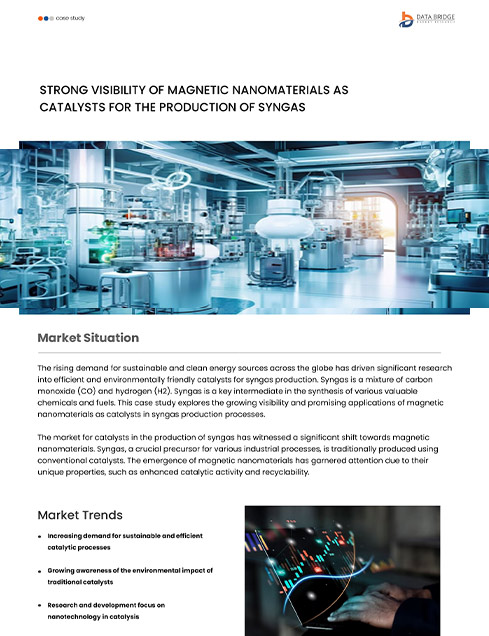Market Situation
The rising demand for sustainable and clean energy sources across the globe has driven significant research into efficient and environmentally friendly catalysts for syngas production. Syngas is a mixture of carbon monoxide (CO) and hydrogen (H2). Syngas is a key intermediate in the synthesis of various valuable chemicals and fuels. This case study explores the growing visibility and promising applications of magnetic nanomaterials as catalysts in syngas production processes.
The market for catalysts in the production of syngas has witnessed a significant shift towards magnetic nanomaterials. Syngas, a crucial precursor for various industrial processes, is traditionally produced using conventional catalysts. The emergence of magnetic nanomaterials has garnered attention due to their unique properties, such as enhanced catalytic activity and recyclability.
Market Trends:
- Increasing demand for sustainable and efficient catalytic processes
- Growing awareness of the environmental impact of traditional catalysts
- Research and development focus on nanotechnology in catalysis
Client Challenges
Clients have faced several challenges in adapting to the shift toward magnetic nanomaterials:
- Limited understanding of the benefits and drawbacks of magnetic nanomaterials
- Uncertainty about the regulatory landscape and potential hurdles in adopting new technologies
- Concerns about the scalability and cost-effectiveness of magnetic nanomaterials in large-scale syngas production
Our Approach
To address the client's challenges, our market research company employed a comprehensive approach and identified the following opportunities to shift to the use of magnetic nanomaterials as catalysts for the production of syngas:
- Enhanced Catalytic Activity
Magnetic nanomaterials, such as magnetic nanoparticles, nanocomposites, and spinel ferrites, exhibit enhanced catalytic activity attributed to their high surface area and unique electronic structure. This property leads to improved conversion rates in syngas production processes.
- Tunable Magnetic Behavior
The tunable magnetic properties of these nanomaterials allow for precise control over the reaction kinetics and selectivity. This feature is crucial for optimizing the syngas production process and tailoring the catalyst for specific applications.
- Stability and Reusability
Magnetic nanocatalysts often demonstrate superior stability and reusability compared to traditional catalysts. Their magnetic nature facilitates easy separation from reaction mixtures, enabling multiple cycles of use without significant loss of catalytic activity.
- Synergy with Renewable Resources
Magnetic nanomaterials can be synthesized from sustainable and renewable resources, aligning with the global push towards green and sustainable technologies. This aspect enhances the environmental friendliness of syngas production processes employing these catalysts.
- Versatility in Syngas Production Routes
Magnetic nanomaterials have demonstrated versatility in catalyzing various syngas production routes, including steam reforming, dry reforming, and partial oxidation of hydrocarbons. This versatility positions them as promising candidates for a wide range of syngas-based applications.
Our Recommendations
Based on our findings, we recommended the following strategies to the client:
- Invest in research and development to optimize magnetic nanomaterials for syngas production
- Establish partnerships with nanotechnology research institutions for continuous innovation
- Engage with regulatory bodies to ensure compliance and address concerns related to nanomaterial use
- Educate stakeholders about the advantages of magnetic nanocatalysts in terms of efficiency and sustainability
Business Impact
The implementation of our recommendations resulted in several positive outcomes for our client:
- Improved understanding of magnetic nanomaterials, leading to more informed decision-making
- Successful development of a scalable and cost-effective magnetic nanocatalyst for syngas production
- Enhanced reputation as an industry leader in adopting innovative and sustainable technologies
- Increased competitiveness and market share due to the superior performance of the magnetic nanocatalyst
Conclusion
In conclusion, the strong visibility of magnetic nanomaterials as catalysts for syngas production represents a transformative opportunity for the industry. The clients have successfully navigated the challenges associated with this shift, reaping the benefits of improved efficiency, sustainability, and market positioning. The case study highlights the importance of proactive adaptation to emerging technologies in a rapidly evolving market landscape. As the world transitions towards sustainable and cleaner energy solutions, these nanomaterials are positioned to play a crucial role in advancing syngas production technologies. Continued research and development in this field are expected to further solidify their position as key catalysts for a sustainable energy future.
